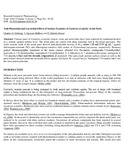| dc.contributor.author | Ochieng, Charles O | |
| dc.contributor.author | Midiwo, J. Ogweno | |
| dc.contributor.author | Owuor, P. Okinda | |
| dc.date.accessioned | 2013-07-03T11:55:07Z | |
| dc.date.available | 2013-07-03T11:55:07Z | |
| dc.date.issued | 2010 | |
| dc.identifier.citation | Charles O. Ochieng, J. Ogweno Midiwo and P. Okinda Owuor (2010). Anti-Plasmodial and Larvicidal Effects of Surface Exudates of Gardenia ternifolia Aerial Parts. Research Journal of Pharmacology, Vol. 4, Issue: 2, Pg No.: 45-50 | en |
| dc.identifier.uri | http://www.medwelljournals.com/fulltext/?doi=rjpharm.2010.45.50 | |
| dc.identifier.uri | http://erepository.uonbi.ac.ke:8080/xmlui/handle/123456789/44660 | |
| dc.description.abstract | Various parts of Gardenia ternifolia (leaves, roots and stem bark) have been reported by traditional healers as a remedy against malaria fever. The aerial parts are coated with shiny materials rich in flavonoid aglycones. The crude acetone wash of the aerial parts showed anti-plasmodial activity of IC50 values 1.06 and 0.94 μg mL-1 against chloroquine-resistant (W2) and chloroquine-sensitive (D6) strains of Plasmodium falciparum, respectively. Bioassay guided chromatographic separation of the crude extracts afforded five flavonoids; (naringenin-7-O-methylether, quercetin-4, 7-O-dimethylether, kaempferol-7-O-methylether, 4, 5-Dihydroxy-6, 7-dimethoxyflavanone, naringenin-4, 7-O-dimethyl-ether) and two steroids; (stigmasterol, β-sitosterol). The same crude acetone surface extract as well as the pure isolates showed moderate larvicidal effects against 2nd instar Ae. aegypti larvae. Naringenin-7-O-methyl-ether was the most potent principle. | en |
| dc.language.iso | en | en |
| dc.title | Anti-Plasmodial and Larvicidal Effects of Surface Exudates of Gardenia ternifolia Aerial Parts | en |
| dc.type | Article | en |

